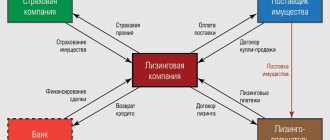This article is devoted to how to reflect a contract, that is, transactions under an assignment agreement in 1C using the example of the 1C: Accounting 8.3 configuration.
An assignment agreement is an assignment of the right to claim receivables, that is, simply put, the sale of such debt to another person. Typically, the debt is sold at a discount, resulting in a loss for the original creditor.
Legislative accounting of the assignment agreement is determined by:
- Civil Code of the Russian Federation - Articles 382-389 (refers to Chapter 24 - Change of persons in an obligation);
- PBU 9/99 – Income of the organization;
- PBU 19/02 – Financial investments – clause 8, clause 9;
- Tax Code of the Russian Federation - Art. 146, 155, 164, 268, 271, 279. When making a transaction between related parties, additional nuances are possible.
Let's consider an example: Organization A sold goods or provided services to organization B in the amount of 120,000 rubles, incl. VAT 20,000 rub. Not receiving payment when due, A sold this debt to organization C for RUB 110,000.
Terminology within the framework of a transaction under an assignment agreement:
- Organization A (original creditor) – Assignor ;
- Organization B (debtor) – Debtor ;
- Organization C (new creditor) – Assignee.
Manual reflection of transactions for registration of an assignment agreement in 1C 8.3 Accounting
Manual entries in this configuration are entered using the “Operations entered manually” documents, which are located in the “Operations” menu:
Get 267 video lessons on 1C for free:
The assignment of the debtor's claims in 1C is reflected by the following entries:
- First posting:
- Dt: 76.09 “Settlements with debtors - creditors.” Analytics is carried out for the counterparty, or more precisely for the “Assignee”.
- Kt: Credit 91.01 “Other income”.
- The transaction amount is the debt of the new creditor (assignee) under the assignment agreement.
- Second wiring:
- Dt: 91.02 “Other expenses”.
- Kt: 62.01 “Settlements with customers.”
- The amount of receivables as they are held by the assignor.
What entries need to be made under the assignment agreement with the assignee?:
- First posting:
- Dt: 58.05 “Providing financial investments.”
- Kt: 76.09 “Settlements with debtors - creditors”, analytics also for the counterparty.
- The transaction amount is the costs actually allocated to the acquisition of remote control.
In the accounting of the assignee, repayment of debt by the debtor occurs as follows:
- Dt: 76 “Settlements with debtors - creditors”, subaccount - “Settlements with the debtor”.
- Kt: 91.01 “Other income”.
- The amount of debt to be collected from the debtor;
- Dt: 91.02 “Other expenses”
- Loan 58.05 “Providing financial investments.”
- The amount is the actual costs received.
- Debit 51 “Current account”.
- Loan 76.09 “Settlements with debtors - creditors”, subaccount - counterparty.
- Amount – actual funds received.
Taxes
For information on how to take into account income and expenses associated with the assignment of claims when calculating taxes, see How the assignor can take into account the assignment of claims when taxing
.
This article is devoted to how to reflect a contract, that is, transactions under an assignment agreement in 1C using the example of BP 8.3 configuration.
An assignment agreement is an assignment of the right to claim receivables, that is, simply put, the sale of such debt to another person. Typically, the debt is sold at a discount, resulting in a loss for the original creditor.
Legislative accounting of the assignment agreement is determined by:
- Civil Code of the Russian Federation - Articles 382-389 (refers to Chapter 24 - Change of persons in an obligation);
- PBU 9/99 – Income of the organization;
- PBU 19/02 – Financial investments – clause 8, clause 9;
- Tax Code of the Russian Federation - Art. 146, 155, 164, 268, 271, 279. When making a transaction between related parties, additional nuances are possible.
Let's look at an example:
Organization A sold goods or provided services to organization B in the amount of 118,000 rubles, incl. VAT 18,000 rub. Not receiving payment when due, A sold this debt to organization C for RUB 108,000.
Terminology within the framework of a transaction under an assignment agreement:
- Organization A (original creditor) – Assignor
; - Organization B (debtor) – Debtor
; - Organization C (new creditor) – Assignee.
BU at the assignor
Dt 62 (balance according to B) 118000. Postings under the assignment agreement:
The loss on the operation will be 10,000 rubles.
If the assignor sold the debt for more than the original amount, then VAT would have to be charged on the excess amount, entry 91.02 - 68.VAT.
Note:
VAT can only be charged on the sale of debt in transactions subject to VAT. If the subject of the transaction is a loan agreement, VAT does not need to be charged even if the amount of the agreement exceeds the actual debt.
NU at the assignor
The loss on the operation is 10,000 rubles.
If the payment deadline has already arrived, the loss is recognized in full. If the payment deadline has not arrived, the loss cannot be taken into account in full in tax accounting. Here you should be guided by the provisions of Art. 279 of the Tax Code of the Russian Federation and the accounting policies of the organization.
It should be noted that the specifics of reflecting losses in such a situation are specially allocated several lines in the income tax return.
In our example, the payment deadline has arrived, so we will take into account the entire amount of the loss in the NU.
BU with the assignee
NU from the assignee
In the case of making a profit from the operation (the type of obligation, loan or debt for the sale of goods does not matter), the assignee considers such amounts to be income subject to income tax. In this case, the cost of the acquired liability, as well as other expenses directly related to this transaction, are taken into account as expenses that reduce the taxable base for profit.
BU at the debtor
The assignment agreement has no tax consequences for the debtor.
Assignment in 1C BP
There are no special documents to reflect assignment operations in the program. Sometimes in this case they use the “Operation” document, where the user manually fills out the necessary transactions. This option has many disadvantages. Firstly, in order to obtain correct reports and fill out regulated reporting, it is often not the postings that are important, but the register entries, which are not generated when using the “Transactions” document. Secondly, there are restrictions on the choice of printing forms.
Based on this, we will try to reflect the assignment agreement in 1C using standard documents, which is easiest to do in this situation by showing the operations of the debtor organization. Let's start with this.
Having received notification of a change of creditor, the debtor must transfer the amount of debt from one counterparty to another. To do this, use the “Debt Adjustment” document, which can be located in the “Purchases and Sales” section.
Create a new document Debt adjustment. In the document:
Type of operation – Transfer of debt; Transfer – Debt to the supplier.
We fill in the data on the creditor and the new supplier from the counterparties directory.
By clicking the “Fill” button, you can automatically generate a tabular part, and, if necessary, later adding the necessary parameters (in our case, these are a New Agreement and a New Account).
Sometimes there is a need to reformat a document, but an error occurs - it is suggested that you first unapprove it. Here you can use the menu option using the “More” button.
Assignment agreement in 1C 8.3 with the assignor
We create a new document for the sale of services, having two options for the input form to choose from.
More details about the details
We change the settlement accounts to 76, the advance payment method – Do not read out.
By type of income, we create a new position with the type of article, as in the figure, and a mark on acceptance to NU.
In this case, there is no consensus on the issue of generating an invoice. On the one hand, there is no object of taxation and no tax to be accrued. On the other hand, if the case of a loan is directly indicated in the Tax Code as not being subject to VAT, then the sale of debt on sales with VAT, under certain conditions, can form the amount of tax. In our example, the sch-f was formed.
To write off debt for expenses, we will use the “Debt Adjustment” document with the appropriate type of transaction. The “Fill” button allows you to create a tabular part on the tab that reflects the buyer’s debt.
For VAT, revenue is the amount of sales to the Debtor.
For profit, the assignment of the debt claim is added to the amount of revenue.
The value of realized property rights is shown as a separate line.
Since revenues do not match between returns, the accountant should be prepared to receive a request from the tax office asking for an explanation of the difference.
Assignment agreement in 1C 8.3 with the assignee
An assignment agreement (assignment of rights to claim a debt) is concluded if the debtor is unable to pay off his obligations. The transaction is regulated by the Civil Code of the Russian Federation (stat. 132 clause 2) and is an operation for the sale of part of the property owned by the enterprise. Let us consider in detail how the assignment agreement is reflected in accounting - the entries are given below.
Accounting for an assignment agreement using a debt adjustment
As I already said, by entering only transactions manually, in most other configurations it is impossible to fully reflect the assignment agreement.
This is interesting: Changes in the law on mandatory audit 2021
Most often, accountants use the “Debt Adjustment” document. It allows you to generate the necessary transactions and at the same time correctly reflect the amounts in the reporting, for example, in the profit declaration.
Here is an example of such an operation:
- Buying debt. Executed by the document “Dog Adjustment” - operation: carrying out mutual settlements:
- Dt: 58.05 - Debtor.
- K: 91.01.
- Amount: 16,000 rub.
- Selling debt. Document “Sales of services”:
- Dt: 79.09 - Creditor Kt. 91.01 = 22,000 rub.
- Dt: 91.02, Kt. = ((22,000-16,000)/118*18 rub.
- The next transaction is for 16,000 rubles. It can also be done through an “adjustment” (operation – debt write-off):
- Dt. 91.02
- Kt. 58.05 - Debtor
- Amount: 16,000 rub.
Legal basis for assignment
Chapter 24 of the Civil Code of the Russian Federation provides that the right to demand the fulfillment of certain obligations can be transferred by the creditor to another person on the basis of an assignment agreement. The parties to the transaction are:
- assignor - the original creditor, the person who assigns the obligation;
- assignee is the recipient of the obligation.
In this case, there is no need to obtain the debtor's consent. He just needs to be notified in a timely manner about the change in creditor so that the debtor promptly and correctly generates entries for the assignment of the right of claim.
If the obligation initially arose on the basis of an agreement concluded in written or notarial form, then the assignment must also be formalized in the appropriate written form.
In commercial activities, the most common assignments of the following obligations are:
- the buyer's debt for goods, products, and services provided;
- debt under the loan agreement;
- the supplier's obligation to deliver the goods for which an advance payment has been made from the buyer.
The assignment agreement is compensated and for the purchase of the right to claim the debt, the assignee must pay the assignor the amount for which the assignment was made.
The transactions of the assignee, assignor and debtor have their own specifics. Let us consider for each party to the transaction which entries under the agreement for the assignment of the right of claim must be generated in accounting.
Postings under the assignment agreement in 1C 8.3
We propose to analyze in detail how, based on the 1C 8.3 Enterprise Accounting 3.0 program, the assignment agreement is reflected. This is determined by the fact that other configurations have, in addition to accounting registers (entries generated manually), also management registers. The creation of register data occurs using documents that are not available in a standard form for registering transactions under an assignment agreement. Let's define the concepts:
An assignment agreement is an agreement for the assignment of rights of claim of the debtor (receivables) to a third party (individual or legal) without the consent of the debtor.
The assignor is the creditor who transfers the rights.
Assignee is a creditor who accepts rights based on an agreement.
Reflection of transactions in the 1C 8.3 Accounting program is completed manually using the document “Operations entered manually.” Located on the Operations menu tab.
Upon assignment of debt in the 1C program, accounting entries must be generated:
Dt 76.09 (Settlements with debtors/creditors) – Kt 91.01 (Other income). In this case, accounting will be kept for the assignee, and the reflected transaction amount will determine the debt of the assignee, the creditor who accepted the rights of assignment on the basis of the assignment agreement.
Dt 91.02 (Other expenses) – Kt 62.01 (Settlements with the buyer). Here the transaction amount will reflect the value recorded by the assignor.
In turn, the assignee under the assignment agreement registers transactions Dt 58.05 (Provision of financial investments) – Kt 76.09 (Settlements with debtors/creditors). The transaction amount will reflect the actual costs of acquiring the receivables.
The repayment of debt by the debtor according to the accounting records of the assignee is recorded by the following entries:
Dt 76 (Settlements with debtors/creditors) – Kt 91.01 (Other income). For debit, you must indicate the subaccount “Settlements with the debtor”. The transaction amount will reflect the value that must be collected from the debtor.
Dt 91.02 (Other expenses) – Kt 58.05 (Provision of financial investments). The amount in this case will reflect the actual value of the funds received.
This is interesting: Mandatory audit of non-profit organizations 2021
As mentioned above, in some 1C programs with a different configuration it is impossible to fully reflect the assignment agreement using manually entered transactions. On the basis of which accountants use the “Debt Adjustment” document. This document makes it possible to generate the necessary entries and correctly reflect the amounts in the accounting reports (for example, a profit declaration). Below is an example of registering this operation:
Dt 58.05 – Kt 91.01. The debit account must go through the debtor. Reflection of the purchase of debt under the document “Adjustment of debt” indicating the type of operation “Carrying out mutual settlements”.
Dt 91.02 – Kt 58.05. The debtor must be indicated on the credit account. The posting is generated based on the “Debt Adjustment” document with the selected type of operation “Debt Write-off”. The amount reflects the balance of the debt.
Accounting – assignment of a future claim
The legislation provides for the possibility of assigning future rights of claim. That is, one that has not yet arisen. For example, the assignor developer may borrow money from the assignee lender against future payments by office tenants in its building. Even when there are no contracts with tenants yet.
However, there is a special condition. The future requirement must be specified in the assignment agreement. Moreover, in such a way that it can be accurately identified at the time of its occurrence and transfer to the assignee. For the example taken, it is possible to prescribe conditions for the assignment by the assignor of the tenants’ obligations to pay him for specific areas at certain rates, a price agreed with the assignee. It could be the following text: “...The assignee receives the right to claim rental payments from an office building area of 1500 sq. m. m. At a rate of 19,000 rubles. per year for 1 sq. m... The assignee receives the right to claim for 85 percent of its value...". Choose any indicator. The main thing is that it allows you to understand exactly what rights of claim the assignor must give up.
By default, the assignee receives the right of claim at the time it arises. The parties to the assignment have the right to agree on a later date of transition by writing a special condition in the agreement.
All this is provided for in Article 388.1 of the Civil Code of the Russian Federation.
Situation: how can the assignor reflect in accounting transactions involving the assignment of a claim that will arise in the future?
The main difference from a regular assignment is that the assignor receives the money before he has a right to claim. This must be reflected in accounting.
In general, reflect such special conditions of the assignment by analogy with an advance payment for a future supply of goods. Only instead of the right of ownership of the property, the right of claim is transferred to the buyer (assignor).
Reflect the receipt of money from the assignee with the following entry:
– financing has been received for the assignment of a future right of claim.
At the same time, accrue . This must be done at the calculated rate provided for in paragraph 4 of Article 164 of the Tax Code of the Russian Federation. That is, according to the following formula:
Make the following entry in your accounting:
Debit 76 subaccount “Calculations for VAT from advances on assignment” Credit 68 subaccount “Calculations for VAT”
– VAT is charged on the received payment for the transfer of the future right of claim.
When transferring the right of claim after its occurrence, make the following entry:
Debit 76 subaccount “Settlements under an agreement for the assignment of a future right of claim” Credit 91-1
– the right to claim under the assignment agreement has been exercised.
At the same time, write off the cost of the realized right of claim as other expenses:
Debit 91-2 Credit 62 (76, 58)
– the value of the realized right of claim under the assignment agreement is written off from the balance sheet.
VAT previously paid to the budget on an advance cannot be deducted. The right to deduction in this case is not provided for by the Tax Code of the Russian Federation. However, VAT can be refunded. That is, return it from the budget or offset it in the manner prescribed by Article 78 of the Tax Code of the Russian Federation. If the right to a tax refund is confirmed, it will be necessary to reflect the resulting budget obligation to the assignee:
– reflects the budget’s obligation to return or offset previously paid VAT amounts from the advance payment by assignment.
In this case, there is no need to reverse VAT entries. After all, at the time of their recording, everything was done correctly. This means there was no error that needed to be corrected.
At the same time, if the assignor exercised the right of claim with benefit, it is necessary to charge VAT on the income received. That is, from the difference between the funds received from the assignee and the book value of the right of claim that passes to it. To do this, make the following entry:
– VAT payable to the budget has been accrued.
All this follows from clauses 6 and 14.1 of PBU 10/99, clauses 6, 7, 10.1 and 16 of PBU 9/99PBU 9/99, Instructions for the chart of accounts (accounts 50, 51, 68, 76, 91), paragraph 2 of clause 1 Article 155, paragraph 1 of Article 167, paragraph 8 of Article 171 and paragraph 6 of Article 172 of the Tax Code of the Russian Federation.
An example of how an assignment of a future claim is reflected in the assignor’s accounting
LLC "Torgovaya" sells industrial equipment and machines. In January, Hermes entered into an assignment agreement with Alpha LLC. According to the agreement, Hermes cedes to Alfa the right to claim the obligations of the buyers of a batch of machines - 100 pcs. The parties agreed that Alpha receives the right to claim by providing Hermes with financing based on the calculation of 100,000 rubles. for each machine in the batch. That is, only 10,000,000 rubles. (100 pcs. × 100,000 rub.). Hermes receives money under the agreement by the end of February. The right of claim passes to Alpha at the moment it arises.
In February, when money was received from Alpha, the Hermes accountant made the following notes:
Debit 51 (50) Credit 76 subaccount “Settlements under an agreement for the assignment of a future right of claim”
– 10,000,000 rub. – financing has been received for the assignment of a future right of claim;
Debit 76 subaccount “Calculations under an agreement for the assignment of a future right of claim” Credit 68 subaccount “Calculations for VAT”
– 1,525,424 rub. (RUB 10,000,000: 118 × 18) – VAT is charged on the payment received for the transfer of the future right of claim.
In March, Hermes sold 70 machines at a price of 105,000 rubles. a piece. The total transaction amount was RUB 7,350,000. (70 pcs. × 105,000 rub.). Including VAT 18 percent – 1,121,186 rubles. (RUB 7,350,000: 118 ×18). The accountant formalized the transaction with the following entries:
Debit 62 Credit 90-1
– 7,350,000 rub. – revenue from the sale of goods is reflected;
Debit 90-3 Credit 68 subaccount “VAT calculations”
– 1,121,186 rub. – VAT is charged on the sale of goods;
Debit 90-2 Credit 41
– 5,390,000 rub. – the cost of goods sold is written off.
Debit 76 subaccount “Settlements under the agreement for assignment of the right of claim” Credit 91-1
– 7,000,000 rub. (70 pcs. × 100,000 rubles) – the assignment of the right of claim is reflected;
Debit 91-2 Credit 62
– 7,350,000 rub. – the value of the sold receivables under the agreement of assignment of the right of claim is written off.
At the same time, part of the VAT from the advance was claimed by the Hermes accountant for reimbursement (offset). After passing the desk check and confirming his eligibility, he made the following entry:
Debit 68 “Calculations for VAT” Credit 76 subaccount “Calculations for VAT from advances on assignment”
–RUB 1,067,797 (RUB 7,000,000: 118 × 18) – reflects the budget’s obligation to reimburse VAT previously paid on the advance.
When assigning the right to demand payment for 70 machines, Hermes suffered a loss. Therefore, the accountant did not need to charge VAT.
In July, Hermes sold the remaining 30 machines in the batch at a price of 98,000 rubles. a piece. The total transaction amount was RUB 2,940,000. (30 pcs. × 98,000 rub.). Including VAT 18 percent – 448,475 rubles. (RUB 2,940,000: 118 × 18). The accountant formalized the transaction with the following entries:
Debit 62 Credit 90-1
– 2,940,000 rub. – revenue from the sale of goods is reflected;
Debit 90-3 Credit 68 subaccount “VAT calculations”
– 448,475 rub. – VAT is charged on the sale of goods;
Debit 90-2 Credit 41
– 2,310,000 rub. – the cost of goods sold is written off.
When selling the machines, Hermes acquired a right of claim. According to the assignment agreement, it goes to Alpha. The Hermes accountant reflected this operation as follows:
Debit 76 subaccount “Settlements under the agreement for assignment of the right of claim” Credit 91-1
– 3,000,000 rub. (30 pcs. × 100,000 rubles) – the assignment of the right of claim is reflected;
Debit 91-2 Credit 62
– RUB 2,940,000.00 – the value of the sold receivables under the agreement of assignment of the right of claim is written off.
At the same time, the accountant set aside part of the VAT from the advance for reimbursement and, after confirming the right to it, made the following entry:
Debit 68 “Calculations for VAT” Credit 76 subaccount “Calculations for VAT from advances on assignment”
– 457,627 rub. (RUB 3,000,000: 118 × 18) – reflects the budget’s obligation to reimburse VAT previously paid on the advance.
Thus, the entire VAT accrued upon receipt of financing was offset (1,525,424 rubles - 1,067,797 rubles - 457,627 rubles).
By assigning the right to demand payment for 30 machines, Hermes received a benefit. He charged VAT on the difference between the financing received from the assignee (“Alpha”) and the cost of the right of claim and reflected this in the accounting records with the following entry:
Debit 91-2 Credit 68 subaccount “VAT calculations”
– 9153 rub. ((RUB 3,000,000 – RUB 2,940,000) :118 × 18) – VAT payable to the budget has been accrued.
Adjusting debt in 1C 8.3 - step-by-step instructions
Very often, accountants in their work are faced with accounts payable and receivable. They can be both from the organization and from the counterparty. There can be many reasons for their occurrence. This includes incorrect data entry into the program, repayment of debt with another equivalent, etc. Debt, as a rule, is revealed in reconciliation reports.
There are two ways to make mutual settlements and adjustments to debt in 1C 8.3: partial repayment of the debt and full repayment (the debt will be fully repaid). Let's look at the step-by-step instructions.
Debt adjustment
Select the “Debt Adjustment” item in the 1C 8.3 “Purchases” or “Sales” menu.
Create a new document from the list form that opens and fill out the header. The most important field is “Type of operation”. Depending on it, the composition of the fields changes. Let's look at these types in more detail:
- Settlement of advances. This type is selected if it is necessary to take into account advances in mutual settlements.
- Debt offset. Selected if it is necessary to change mutual settlements against the debt of the counterparty to us, or a third party.
- Transfer of debt. This type is necessary for transferring debts, advances between counterparties or contracts.
- Debt write-off. This implies complete write-off of the debt.
- Other adjustments.
An example of writing off accounts payable in 1C 8.3
Let's move on to filling out the main part of the document. This can be done automatically using the button of the same name, but keep in mind that there are two of them on the form. In this case, there is no difference, just as with the selected type of operation “Debt transfer”. In other cases, the “Fill” button, which is located at the top of the form, will fill in both accounts payable and accounts receivable.
This is interesting: Final balance sheet during reorganization in the form of merger 2021
Manual input is also available here. It is convenient in cases where adjustments are made based on one or two documents.
Next, fill out the “Write-off account” tab. In our example, we specified the account as 91.01. In the case where the debt is not with us, but with the counterparty to us, it is necessary to indicate account 91.02.
What document should be used to reflect the assignment?
The organization creates reserves for doubtful debts in accounting and for profit tax purposes. The balance sheet for account 62.01 and the balance sheet for account 60.01 for 2021 are presented in Fig. 1: Doubtful debt is any debt to the taxpayer arising in connection with the sale of goods, performance of work, provision of services, if this debt is not repaid within the time period established by the agreement and is not secured by a pledge, surety, or bank guarantee. If the taxpayer has a counter-obligation (accounts payable) to the counterparty, the corresponding debt to the taxpayer to the extent that exceeds the specified payables of the taxpayer to this counterparty is recognized as a doubtful debt (clause 1 of Article 266 of the Tax Code of the Russian Federation).
Manual reflection of transactions for registration of an assignment agreement in 1C
To perform manual entries, you must use the “Operations” menu - the “Operations entered manually” subsection.
To carry out the assignment, you need to generate a couple of transactions:
Debit 76.09 “Settlements with debtors - creditors” - Credit 91.01 “Other income”. The amount reflected in the posting corresponds to the amount of debt of the new creditor.
Debit 91.01. “Other income” - Loan 62.01 “Settlements with customers.” The amount indicated is equal to the value of the assignor.
Postings to be completed under the assignment agreement with the assignee
Debit 58.05 “Providing financial payments” Credit 76.09 “Settlements with debtors - creditors”. The amount of funds is equal to the amount of costs incurred in the process of acquiring receivables.
According to the assignee's accounting, a posting is made Debit 76 Credit 91.01 “Other income”. The indicated amount is equal to the amount of the debt being collected.
Debit 91.02 Credit 58.05 “Provision of financial investments” for the amount of costs received.
Debit 51 Credit 76.09 for the amount of funds actually received.
Results
So, we have looked at what entries under the assignment agreement are made by its participants if the enterprises are VAT payers. In conclusion, let’s say that for some entrepreneurs, assignment agreements can be an interesting business, and for others, they can be a sure way to get their money. But you need to understand that the assignor, after concluding the contract, is not responsible and does not guarantee that the debtor will pay the entire debt.
What to pay attention to when concluding an agreement
with simplified taxation system payers or individuals , read the articles :
- “Assignment agreement under the simplified tax system, income minus expenses (nuances)”;
- “Physicist” received performance on a loan acquired by assignment. What about personal income tax? .
The cost of the right of claim, at which it is recorded on the assignor’s balance sheet, is reflected as part of other expenses in the debit of account 91 (clauses 6 and 14.1 of PBU 10/99). In this case, on the date of signing the assignment agreement, make the following entry in accounting:
When you receive payment from the assignee under an assignment agreement, make the following entry:
Debit 51 (50) Credit 76 subaccount “Settlements under the agreement for assignment of the right of claim”
– payment has been received from the assignee under the assignment agreement.
This procedure follows from the Instructions for the chart of accounts (accounts 76, 91).
An example of how an assignment of a right of claim is reflected in accounting. Accounting with the assignor
On March 16, Alfa CJSC sold goods worth 165,200 rubles. (including VAT – 25,200 rubles). The cost of goods sold is 120,000 rubles.
On April 20, Alpha assigned the right to claim receivables to another organization for 160,000 rubles. This amount was transferred to Alpha's account on May 17.
Since the income from the assignment of the right of claim (160,000 rubles) does not exceed the value of the claim itself (165,200 rubles), the VAT tax base does not arise for Alpha.
Alpha's accountant made the following entries in accounting.
Debit 62 Credit 90-1
– 165,200 rub. – revenue from the sale of goods is reflected;
– 25,200 rub. – VAT is charged on the sale of goods;
Debit 90-2 Credit 41
– 120,000 rub. – the cost of goods sold is written off.
– 160,000 rub. – the assignment of the right of claim is reflected;
Debit 91-2 Credit 62
– 165,200 rub. – the value of the sold receivables under the agreement of assignment of the right of claim is written off.
Debit 51 Credit 76 subaccount “Settlements under the agreement for assignment of the right of claim”
– 160,000 rub. – money has been received from the assignee under the agreement of assignment of the right of claim.








